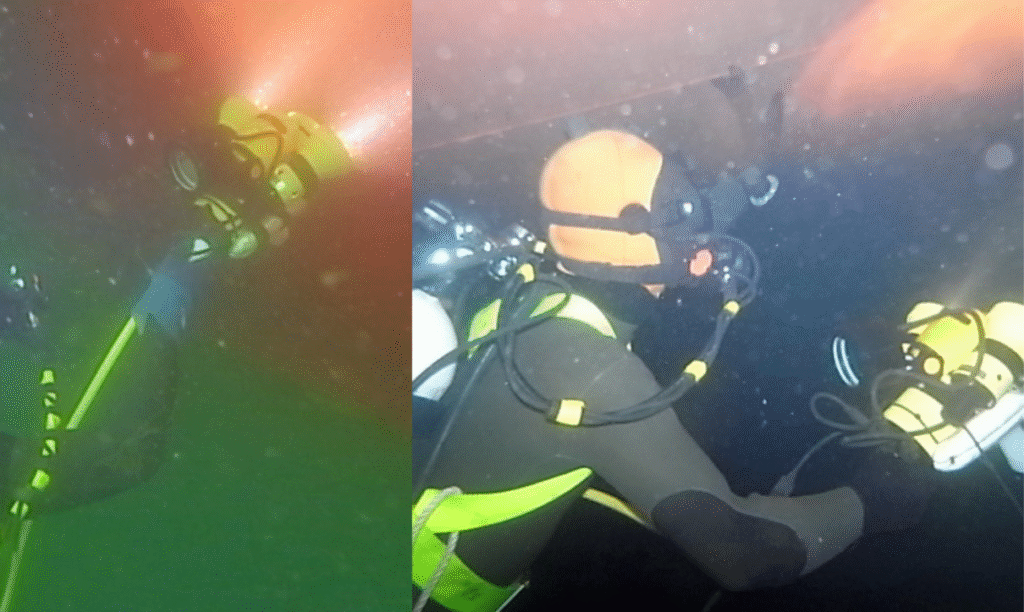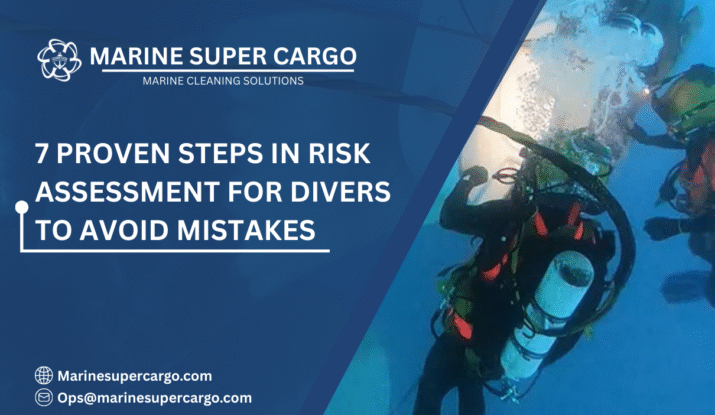When you think about diving operations, what’s the first image that comes to mind? Perhaps divers working underwater, inspecting hulls, cleaning biofouling, or performing repairs, all in silence. But beneath the surface lies not just the ocean—it’s a world of risks. That’s why a Risk Assessment for Divers is not only a legal requirement but also a lifeline protecting both divers and the crew supporting them.
In this guide, we’ll uncover why risk assessment matters, break down the essentials, and walk through real-world examples to help you create safer, smarter underwater operations for your team.
Whether you’re a ship owner scheduling hull cleaning, a diving supervisor, or a crewmember supporting the team, this article is your one-stop manual for safety, compliance, and peace of mind.
Why Risk Assessment for Divers Matters
At sea, the margin for error is razor-thin. A minor oversight during a dive can trigger a chain of consequences, including injuries, vessel delays, environmental violations, or even fatalities.
Conducting a Risk Assessment for Divers:
- Protects human life, the highest priority.
- Prevents costly downtime caused by accidents.
- Ensures compliance with international standards like IMCA guidelines, IMO conventions, and MARPOL regulations.
- Reduces legal liabilities and insurance costs.
- Promotes a culture of safety that empowers your team.
Think of risk assessment as a compass: without it, you’re just guessing your way through opaque waters. With it, you chart a clear course to safety.

Core Principles of Diving Risk Assessment
A comprehensive Risk Assessment for Divers must focus on three main areas:
- Human Factors: Skill level, experience, fatigue, and mental preparedness of divers.
- Environmental Conditions: Weather, currents, visibility, and water temperature.
- Operational Hazards: Equipment reliability, vessel traffic, entrapment risks, and communication protocols.
These pillars serve as your foundation. Without them, the risk assessment is incomplete, leaving divers exposed to danger.
The Step-by-Step Process of Risk Assessment for Divers
Here’s a structured approach widely used by organizations like the International Marine Contractors Association (IMCA) and adapted by ship operators worldwide.
- Identify Hazards
Ask: What could go wrong? Examples include decompression sickness, entanglement, or loss of communication. - Assess the Risks
Measure both likelihood and severity. For instance, the chance of poor visibility may be high, but its severity depends on the operation. - Review Controls in Place
What measures already exist to reduce risks? Emergency oxygen, diver recall systems, and hull cleaning SOPs are examples. - Implement Additional Controls
Close gaps by introducing backup plans—like assigning safety divers or enforcing strict stop-work authority. - Monitor and Review
Conditions change quickly in marine operations. Continuous assessment ensures risks are spotted early.
Common Diving Hazards and Controls
- Decompression Illness → Strict adherence to dive tables and surface intervals.
- Entanglement → Use of cutting tools, communication checks, and buddy systems.
- Equipment Malfunction → Pre-dive inspections, certified gear, redundant systems.
- Noise and Stress → Crew fatigue management, realistic work-rest cycles.
- Pollution Hazards → Compliance with MARPOL Convention to avoid chemical or oil exposure.
When you list these hazards out, it becomes clear: a good Risk Assessment for Divers is less about paperwork and more about foreseeing problems before they spiral.
The Crew’s Role in Diving Risk Assessment
Diving risk assessment isn’t just for divers—it involves the entire crew. After all, support staff provide critical links in communication, logistics, and emergency response.
- Masters and Officers: Ensure vessel positioning and compliance with maritime safety rules.
- Deck Crew: Handle equipment, monitor bubbles, and assist in emergencies.
- Engineers: Maintain compressors and life-support systems.
- Safety Officers: Conduct real-time hazard checks and stop unsafe work.
By treating the crew as active guardians, you distribute responsibility and reduce blind spots. Also, read about underwater hull cleaning in Australia.
Legal and Compliance Frameworks
You cannot ignore the role of international regulations in making diving operations safe. Key frameworks include:
- IMCA Guidelines for commercial diving operations.
- International Maritime Organization (IMO) conventions on safety at sea.
- MARPOL for environmental safeguards to reduce pollution risks during diving and hull cleaning.
- IAPH guidance for port-safe diving operations.
Being compliant is not just about avoiding penalties. It’s about protecting your divers, your vessel, and your client relationships.
Case Study: Hull Cleaning Without Risk Assessment
Consider this: A shipowner schedules underwater hull cleaning, but skips a structured Risk Assessment for Divers. Divers enter murky waters where poor visibility hides fishing nets entangled on the propeller. Within minutes, one diver is stuck. Panic sets in. Search and rescue is delayed due to a standby diver.
Now imagine the alternative: With proper assessment, the crew identifies entanglement as a hazard, assigns a safety diver, and maintains clear comms. What was a near-fatal accident becomes a routine job. That’s the difference risk assessment makes.
🌊✨ Client Testimonial Spotlight ✨🌊
— Marine Super Cargo (@Marinsupercargo) September 16, 2025
💬 “The team at Marine Super Cargo feels like part of our crew. From hold cleaning to supercargo support, they handle everything seamlessly. Their quick response and reliable service saved us valuable time and money.” – Mr. Ingmar Domrös pic.twitter.com/bPlooKOakt
Future Trends in Diving Risk Assessment
The world of diving is evolving, and so is risk assessment:
- Digital Monitoring: AI-based systems track diver biometrics in real-time.
- ROVs (Remotely Operated Vehicles): Reducing diver exposure by performing hazardous inspections.
- Predictive Analytics: Using weather and tide data to forecast high-risk dive windows.
- Green Compliance Tools: Linking hull cleaning practices with environmental monitoring to meet MARPOL standards sustainably.
By embracing innovation, ship operators can protect divers better while controlling costs.

Practical Tips for Ship Owners and Managers
- Never treat risk assessment as a one-time formality—it’s a living document.
- Train not just divers but also the entire crew on safety protocols.
- Use standard checklists but allow flexibility for unique job conditions.
- Always link operations to compliance frameworks—it saves time later if auditors come calling.
- Document near-misses. They are warnings for future risks.
When applied consistently, these small habits keep bigger dangers at bay.
Conclusion
A Risk Assessment for Divers isn’t just about ticking legal boxes—it’s about life, safety, and responsibility. The three key takeaways:
- Proper assessment prevents injuries and saves lives.
- Engaging the whole crew strengthens safety nets.
- Compliance with IMCA, IMO, and MARPOL ensures sustainable, lawful operations.
For ship owners and operators serious about safe, eco-friendly diving, turn to industry experts like CleanShip.co for guidance and solutions that combine safety with sustainability.
FAQs:
Q1. Why is Risk Assessment for Divers critical in hull cleaning?
It reduces hazards like entanglement, poor visibility, and biofouling exposure, ensuring divers operate in safe conditions.
Q2. Who is responsible for carrying out diving risk assessments?
Usually, the diving supervisor leads the assessment, but ship owners, crew, and safety officers all share responsibility.
Q3. How often should a diving risk assessment be updated?
Before every operation, and immediately if environmental or task conditions change.
Q4. What international standards apply to diving safety?
Guidelines from IMCA, IMO safety conventions, and MARPOL environmental standards are the benchmarks.
Q5. Can technology help improve Risk Assessment for Divers?
Yes, innovations like real-time biometrics and ROVs reduce exposure, while predictive analytics improve planning accuracy.


